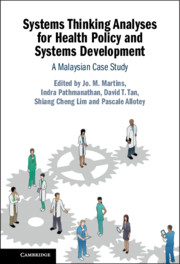Appendix I Systems Thinking Analysis of STC
In the 1960s and 1970s, demand for more sophisticated medical care increased. Unable to obtain such care in clinics and smaller hospitals, patients bypassed those in favour of major hospitals, which became overcrowded. Public hospital capacity lagged behind demand, creating a gap that reduced the quality of care. The government attempted to upgrade hospitals and increase the number of specialists to reduce the gap (B1 loop) but was limited by the availability of funding (Figure 5-a).
Despite continued government investment, a gap remained between the demand for healthcare and public sector capacity to provide it. Figure 5-b demonstrates how, in the 1970s and 1980s, rising societal affluence increased the demand for sophisticated healthcare while also growing the population segment that could afford to pay for private care. This created private sector opportunities that were welcomed by public sector specialists facing high patient loads and inadequate support. However, the movement of these specialists out of the public sector further undermined public sector capacity, as illustrated by the reinforcing loop R1. Meanwhile, the growth of the private sector created a fragmentation of healthcare providers both between the public and private sectors and within the private sector.

Figure 5-b In the 1970s and 1980s, rising societal affluence further increased the demand for sophisticated healthcare, resulting in the growth of the private sector STC, drained specialists from the public sector to the private sector and counteracted efforts to increase public sector capacity.
Figure 5-c illustrates that the public sector used new strategies to address capacity shortfalls. The public sector further invested in increasing clinical specialists (B1 loop) and emphasised health management and quality improvement (B2 loop), including information for performance monitoring and managerial strategies for quality improvement. While outcomes improved, unintended effects surfaced from the growing numbers and types of specialisation. Clinical treatment expertise and service delivery modalities in the public and private sectors became increasingly compartmentalised, with the development of silos in caregiving (R2 loop).

Figure 5-c Increased investment resulted in increased availability of specialist services but was associated with the unanticipated effect of increased compartmentalisation of care.
Figure 5-d demonstrates that in the 2000s onward, the public sector responded to the development of silos by investing in organisational structure (B3 loop) to bridge silos. This includes the creation of hospital clusters to share specialists and other resources, integrating hospital OPDs with PHC facilities, and creating new modalities of treatment such as telemedicine and day-care centres to improve access and integration.

Figure 5-d Investment in public sector organisational structure improved the capacity to deal with compartmentalisation.
Despite continual improvements to the public healthcare system, demand for private sector care has remained strong. Private sector care has become corporatised and supporting structures such as private insurance and medical tourism have developed, creating a self-sustaining industry and supplier-driven demand (R3 loop). While the private sector alleviates the burden of the public sector in some ways, it continues to draw medical practitioners, especially specialists, away from the public sector and creates challenging tensions regarding the locus of responsibility for the provision and payment of healthcare.




